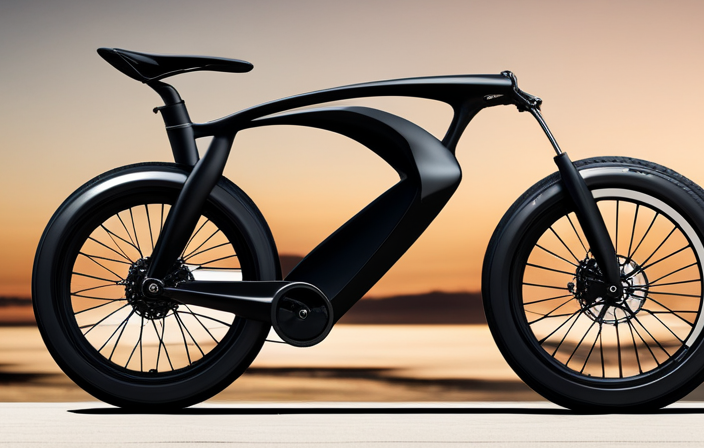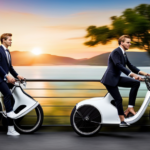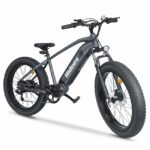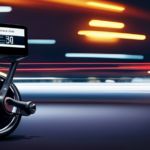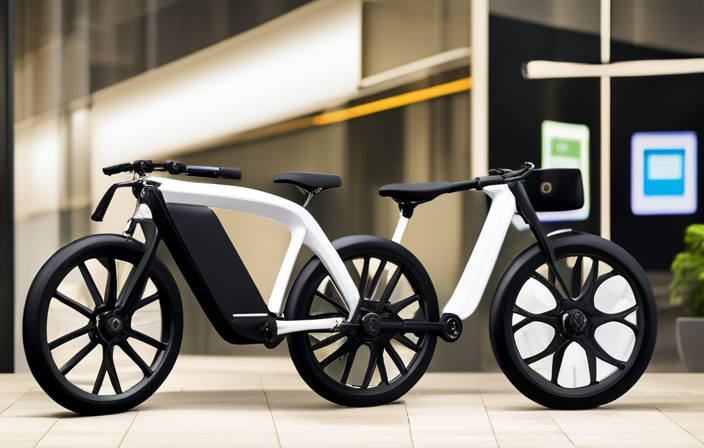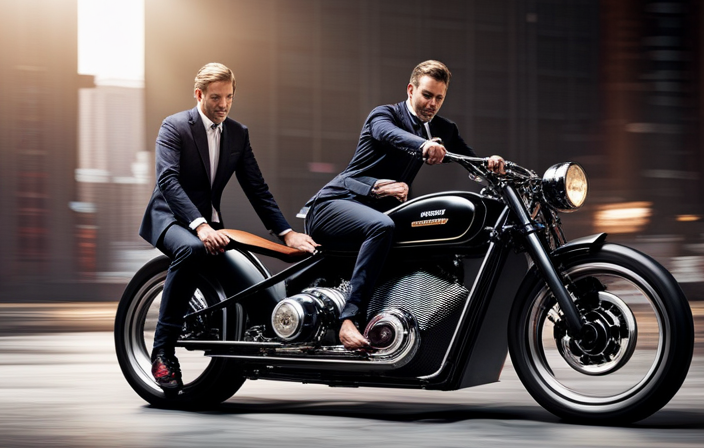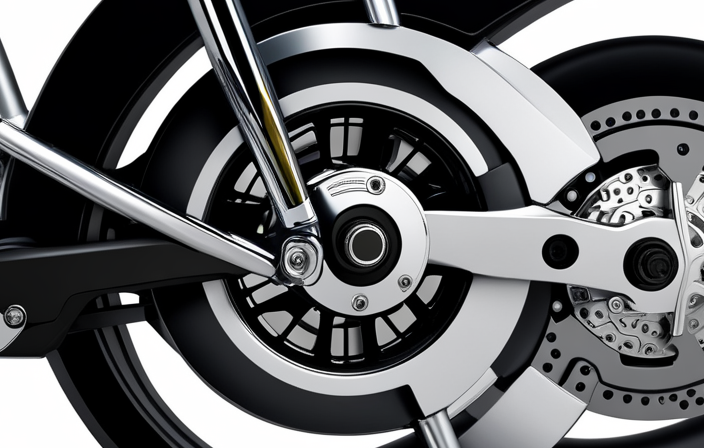Looking for an electric bike can be an exhilarating journey, filled with endless possibilities and freedom. With the ever-growing popularity of electric bikes, it’s important to know what to look for to ensure you find the perfect one.
In this article, I will guide you through the key factors to consider when making your decision. From motor power to battery range, frame material to extra features, and even local regulations and laws, I’ve got you covered.
So let’s dive in and discover the electric bike that will revolutionize your ride.
Key Takeaways
- Motor Power: Consider the motor power of the electric bike to ensure it can handle hills and provide an exciting ride.
- Battery Range: Look for an electric bike with a sufficient battery range to meet your travel needs on a single charge.
- Frame Material: Consider the frame material of the bike as it can affect the performance and ride quality.
- Extra Features: Look for electric bikes that offer additional accessories and safety features to enhance your riding experience.
Motor Power
When looking for an electric bike, it’s important to consider the motor power. This is what will determine the bike’s ability to effortlessly conquer steep hills and provide a thrilling ride. The motor power of an electric bike is measured in watts and typically ranges from 250W to 750W.
A higher motor power will provide more torque and enable the bike to tackle challenging terrains with ease. Additionally, a powerful motor ensures faster acceleration and a smooth ride. However, it’s important to note that a higher motor power may also drain the battery faster, affecting the overall battery range.
Therefore, it’s crucial to strike a balance between motor power and battery range to ensure optimal performance. Speaking of battery range, let’s now move on to discuss this crucial aspect of electric bikes.
Battery Range
One crucial factor to consider is the mileage an e-bike battery can cover, as it determines how far you can go on a single charge. The battery range of an electric bike is influenced by various factors, such as the weight distribution on the bike and the battery charging capabilities. Optimal weight distribution can improve the overall performance and efficiency of the bike, allowing for a longer battery range.
Additionally, the battery charging time and speed can vary depending on the model and technology used. It is important to choose an electric bike with a battery that offers a sufficient range for your needs, whether it is for daily commuting or longer rides.
With a good understanding of battery range and its impact on your riding experience, you can now move on to considering the next important aspect of an electric bike: the frame material.
Frame Material
To truly appreciate the craftsmanship and durability of an e-bike, imagine yourself gliding effortlessly down the road on a frame material that feels like an extension of your own body. The choice of frame material plays a crucial role in the overall performance and ride quality of an electric bike.
One important aspect to consider is weight distribution. A well-designed frame material can help distribute the weight of the battery and motor evenly, resulting in better balance and stability.
Additionally, frame geometry is another key factor to look for. The right frame geometry can enhance the handling and responsiveness of the bike, making it more agile and enjoyable to ride.
When considering an electric bike, it is important to pay attention to these aspects to ensure a comfortable and enjoyable riding experience.
As we move onto the next section about ‘extra features’, it’s important to note that these elements can further enhance your e-bike experience.
Extra Features
Imagine cruising effortlessly on an e-bike equipped with additional features that elevate your riding experience to a whole new level of sophistication and enjoyment.
Electric bike accessories can enhance your ride in various ways. For instance, consider investing in a comfortable saddle, ergonomic handlebars, and a sturdy rack to carry your belongings.
Safety features are also important when choosing an electric bike. Look for models that come with integrated lights for increased visibility, as well as reflective strips or decals. Some bikes even offer built-in alarms or GPS trackers for added security.
Now, let’s shift our focus to the next important aspect of an electric bike: the braking system.
Braking System
When considering the braking system of an electric bike, it is important to determine whether it has hydraulic or mechanical disc brakes.
Hydraulic disc brakes generally provide better stopping power and more responsiveness compared to mechanical disc brakes.
Additionally, evaluating if the electric bike has regenerative braking is crucial for energy efficiency, as it allows the bike to convert the kinetic energy generated during braking into electrical energy that can be stored and used later.
Determine if the electric bike has hydraulic or mechanical disc brakes
Check if the electric bike you’re considering has hydraulic or mechanical disc brakes by looking for a fluid-filled system or a cable-operated system.
To determine if the electric bike has hydraulic or mechanical disc brakes, consider the following:
-
Hydraulic vs Mechanical: Hydraulic disc brakes use fluid to transmit force, providing better modulation and stopping power compared to mechanical disc brakes, which rely on cables.
-
Importance of braking system innovation: Hydraulic disc brakes have been a significant advancement in electric bikes as they offer improved reliability, consistent performance, and require less maintenance compared to mechanical disc brakes.
-
Fluid-filled system: Look for a fluid reservoir near the brake lever or caliper to identify a hydraulic disc brake system. This system provides better control and more precise braking.
-
Cable-operated system: If you notice a cable connecting the brake lever to the caliper, it indicates a mechanical disc brake system. While mechanical disc brakes are more affordable, they may require more frequent adjustments and provide less precise braking.
Consider the stopping power and responsiveness of the brakes as you move into the subsequent section.
Consider the stopping power and responsiveness of the brakes
Now, picture yourself cruising down a steep hill at top speed, feeling the wind rush through your hair. The moment you decide to hit the brakes, you want to be confident that they will respond instantly and bring you to a safe stop.
When considering the stopping power and responsiveness of the brakes on an electric bike, it is crucial to prioritize braking efficiency and safety features. Look for electric bikes that have high-quality disc brakes, whether hydraulic or mechanical, as they provide better stopping power compared to traditional rim brakes.
Hydraulic disc brakes are known for their superior performance, offering excellent modulation and consistent stopping power in various conditions. On the other hand, mechanical disc brakes are more budget-friendly but still offer reliable braking.
By ensuring that your electric bike has brakes with optimal stopping power and responsiveness, you can ride with peace of mind, knowing that you can rely on them when you need to stop quickly or navigate challenging terrains.
Now, let’s move on to evaluating if the electric bike has regenerative braking for energy efficiency.
Evaluate if the electric bike has regenerative braking for energy efficiency
Consider evaluating whether the presence of regenerative braking enhances the energy efficiency of your electric bike. Regenerative braking is a technology that allows the bike to recover and store energy that is typically lost during braking. Here are three advantages of regenerative braking to consider:
-
Increased range: Regenerative braking can extend the range of your electric bike by converting the energy that would have been lost into usable power. This means you can go further on a single charge.
-
Improved battery life: By using regenerative braking, the battery is subjected to less stress and wear. This can lengthen the overall lifespan of the battery, saving you money in the long run.
-
Eco-friendly: Regenerative braking reduces energy waste, making it a more environmentally friendly option compared to traditional braking systems.
However, there are a few disadvantages to keep in mind:
-
Cost: Electric bikes with regenerative braking tend to be more expensive due to the added technology.
-
Complexity: The regenerative braking system can add complexity to the bike’s overall design, which may require more maintenance and repairs.
-
Limited effectiveness: Regenerative braking is most effective at higher speeds and during sudden stops. At slower speeds or during gradual stops, its benefits may be minimal.
Considering the advantages and disadvantages, it is important to weigh the impact of regenerative braking on the overall performance and efficiency of your electric bike.
Moving onto the subsequent section about ‘weight capacity’, it is crucial to evaluate this aspect for a well-rounded understanding of the bike’s capabilities.
Weight Capacity
Make sure the electric bike you choose has a weight capacity that can accommodate your body weight and any additional cargo you may be carrying, such as groceries or a backpack. This is important because exceeding the weight capacity can affect the performance and safety of the bike.
For instance, if you weigh 200 pounds and regularly carry around 50 pounds of groceries, you would need an electric bike with a weight capacity of at least 250 pounds to ensure safe and efficient riding. Additionally, consider the motor power of the electric bike, as it should be able to handle the combined weight of you, your cargo, and the bike itself.
By selecting an electric bike with the appropriate weight capacity and motor power, you can enjoy a smooth and comfortable ride.
Moving on to comfort and ergonomics, it’s essential to choose an electric bike that suits your body type and provides a comfortable riding experience.
Comfort and Ergonomics
Imagine gliding through the streets on a sleek and stylish ride that perfectly aligns with your body type, providing utmost comfort and an ergonomic design. When looking for an electric bike, comfort and ergonomics are key factors to consider.
Here are some important aspects to pay attention to:
-
Comfort and adjustability: Look for a bike that allows you to adjust the seat height and angle, ensuring a comfortable riding position.
-
Handlebar position and grip: Opt for a bike that offers adjustable handlebars, allowing you to find the perfect position for your arms and hands. Additionally, consider bikes with ergonomic grips that provide a firm and comfortable hold.
By prioritizing comfort and ergonomics, you can ensure an enjoyable and pain-free riding experience.
Now, let’s move on to the next section and explore the importance of tires in electric bikes.
Tires
When considering the tires on an electric bike, it’s important to determine their size and type to ensure they meet your specific needs.
For example, if you plan on riding off-road or on rough terrain, you may want to opt for wider tires with more aggressive tread patterns.
Additionally, evaluating the grip, puncture resistance, and rolling resistance of the tires is crucial in determining their overall performance and durability.
So, before making a decision, take the time to thoroughly assess the tires and ensure they are suitable for your intended riding terrain.
Determine the size and type of tires on the electric bike
Deciding on the right electric bike means feeling the thrill of gliding effortlessly on different terrains with the perfect tire size and type.
One important aspect to consider when choosing an electric bike is the size and type of tires. The tire size determines the overall performance and comfort of the bike, while the tire type affects its suitability for different terrains.
When looking at tire size, it is essential to consider the tire pressure as well. The ideal tire pressure ensures optimal performance and a smooth ride.
Additionally, paying attention to tire tread patterns is crucial. Different tread patterns offer varying levels of traction and grip, making them suitable for specific terrains.
Considering if the tires are suitable for your intended riding terrain is essential for a safe and enjoyable biking experience.
Consider if the tires are suitable for your intended riding terrain
Ensure your tires are a perfect match for your preferred riding terrain to guarantee an exhilarating and worry-free biking adventure. One important factor to consider is tire pressure, as it directly affects the performance and comfort of your electric bike. Different riding terrains require different tire pressures, so it’s crucial to find the right balance. Additionally, the tread pattern of the tires plays a significant role in providing traction and stability. A deeper tread pattern is ideal for off-road trails, while a smoother tread pattern is better suited for pavement or urban riding. To emphasize these points, refer to the table below:
| Terrain Type | Tire Pressure | Tread Pattern |
|---|---|---|
| Off-road trails | Lower pressure | Deeper tread |
| Pavement/urban | Higher pressure | Smoother tread |
By considering the tire pressure and tread pattern, you can ensure your electric bike is equipped with the right tires for your intended riding terrain. Evaluating the grip, puncture resistance, and rolling resistance of the tires will further enhance your biking experience.
Evaluate the grip, puncture resistance, and rolling resistance of the tires
To truly unlock the potential of your two-wheeled companion, feel the grip of the tires, dance with their puncture resistance, and embrace the smooth flow of their rolling resistance.
When evaluating an electric bike, it is crucial to assess the tire grip and traction. The tires should provide excellent grip on various terrains, ensuring stability and control during your rides. Additionally, it is essential to consider the durability and longevity of the tires. Look for tires that are resistant to punctures, as they can prevent unexpected flats and prolong the lifespan of your bike.
By evaluating these factors, you can ensure a safe and enjoyable riding experience.
Now, let’s explore the next section about speed and range modes, where we’ll discuss how to optimize your electric bike’s performance.
Speed and Range Modes
When choosing an electric bike, it’s important to consider the different speed and range modes it offers. Electric bike speed control allows you to adjust the speed according to your preference and riding conditions. This feature is especially useful when navigating through traffic or climbing steep hills.
On the other hand, electric bike battery capacity determines how far you can travel on a single charge. It’s essential to choose a bike with a battery that meets your commuting or recreational needs. Some bikes offer multiple range modes, allowing you to choose between a higher top speed with a shorter range or a lower top speed with a longer range.
Considering these factors will ensure that you find an electric bike that suits your specific requirements.
Now, let’s delve into the next section about warranty and customer support.
Warranty and Customer Support
If you encounter any issues or have questions about your purchase, rest assured that there is a comprehensive warranty and dedicated customer support available to assist you. When considering an electric bike, it’s important to look for a warranty that provides extensive coverage. A good warranty should cover not only the frame but also the motor, battery, and other crucial components. This ensures that you are protected in case of any manufacturing defects or malfunctions.
Additionally, the quality of customer service is equally important. Look for a company that has a reputation for providing prompt and helpful support. It can make all the difference when you need assistance with troubleshooting or getting replacement parts.
Now, let’s move on to the next aspect to consider: price.
Price
When it comes to purchasing an electric bike, it’s important to set a budget that aligns with your financial capabilities. This will help narrow down your options and ensure you make a wise investment.
Additionally, I recommend comparing prices from different brands and retailers to find the best deal. However, keep in mind that price shouldn’t be the sole determining factor.
Consider the overall value for money based on the features and quality of the electric bike to ensure you’re getting the most bang for your buck.
Set a budget for your electric bike purchase
First, you need to decide on your budget for buying an electric bike. Remember that on average, electric bikes range in price from $500 to $3000. Setting a budget is crucial to ensure you make a wise investment. Many people make the mistake of either overspending or settling for a low-quality bike due to budget constraints.
To avoid these common mistakes, consider the following when setting your budget:
- Determine how often you will use the electric bike and for what purposes.
- Research the average prices of electric bikes with the features you desire.
- Consider additional costs such as accessories, maintenance, and warranties.
Once you have set your budget, the next step is to compare prices from different brands and retailers. This will help you find the best deal for a high-quality electric bike that meets your needs and fits within your budget.
Compare prices from different brands and retailers
To ensure you find the most cost-effective option, it is essential to compare prices from various reputable brands and retailers.
When it comes to electric bikes, not only do you need to consider the upfront cost, but also the long-term expenses like electric bike maintenance.
Researching and comparing prices will give you an idea of what is reasonable and what might be overpriced. Additionally, comparing prices allows you to take advantage of any discounts or promotions that different brands and retailers may offer.
It’s important to remember that a higher price doesn’t always guarantee better quality or features. By comparing prices, you can find the best balance between cost and value.
Considering the overall value for money based on the features and quality of the electric bike will guide you towards making an informed decision in your purchase.
Consider the overall value for money based on the features and quality of the electric bike
Considering the overall bang for your buck, it’s important to weigh the features and quality of different electric bikes to make an informed purchasing decision. Here are some key factors to consider:
-
Motor Power Comparison: Look for an electric bike with a powerful motor that suits your needs. Higher motor power will provide better acceleration and hill climbing abilities.
-
Battery Life Estimation: Consider the battery life of the electric bike. Look for a bike with a long-lasting battery that can cover the distance you plan to ride. Check the estimated range provided by the manufacturer.
-
Features: Assess the additional features offered by the electric bike. Look for features like adjustable suspension, integrated lights, and a comfortable saddle. These features can enhance your riding experience.
-
Quality: Evaluate the overall build quality of the electric bike. Check the frame material, components, and overall durability. A well-built bike will last longer and provide a better value for money.
When considering all these factors, you can make a more informed decision about the electric bike that offers the best overall value for your money. Once you have narrowed down your options, it’s time to move on to the next step: test rides and reviews.
Test Rides and Reviews
When it comes to buying an electric bike, there are a few key points to consider.
First, I highly recommend visiting local electric bike dealerships for test rides. This will allow you to get a feel for different models and see which one suits your needs and preferences.
Second, it’s important to do your research and read reviews from reputable sources and customers. This will give you a better understanding of the pros and cons of each bike and help you make an informed decision.
Lastly, don’t forget to consider the experiences and feedback of other electric bike owners. They can provide valuable insights and recommendations based on their firsthand experiences.
Visit local electric bike dealerships for test rides
Explore the thrilling world of electric bikes firsthand by hopping on for a test ride at your local dealership. It’s crucial to test ride different models to ensure a proper bike fit, as each person’s body is unique. A well-fitting electric bike will provide optimal comfort and performance, enhancing your overall riding experience. Electric bikes offer numerous benefits for commuting, such as reducing traffic congestion and lowering carbon emissions. With the ability to effortlessly cover long distances, you’ll arrive at your destination feeling refreshed and energized. To evoke an emotional response, consider this table:
| Proper Bike Fit | Benefits of Electric Bike Commuting | |
|---|---|---|
| Feeling | Comfortable | Empowered |
| Result | Enhanced Ride | Reduced Carbon Footprint |
| Experience | Optimal Performance | Efficient and Time-Saving |
Visiting local dealerships is just the first step. To make an informed decision, it’s essential to research and read reviews from reputable sources and customers.
Research and read reviews from reputable sources and customers
To truly immerse yourself in the world of electric bikes, don’t miss the opportunity to delve into research and read reviews from trusted sources and fellow customers. This step is crucial in determining the electric bike’s performance and overall customer satisfaction.
By researching and reading reviews, you can gain valuable insights into the different models available, their features, and how they perform in real-world situations. Reputable sources such as cycling magazines, websites, and forums often conduct thorough tests and provide detailed reviews that can help you make an informed decision.
Additionally, reading reviews from customers who have already purchased and used electric bikes can give you a sense of their experiences and any potential issues to consider. Understanding the experiences and feedback of other electric bike owners is essential in ensuring that you find the perfect electric bike for your needs.
Consider the experiences and feedback of other electric bike owners
Discover the valuable insights and firsthand experiences shared by other electric bike owners to gain a deeper understanding of what it’s like to own and ride one. Here are three key takeaways from their experiences and feedback:
-
Range and Battery Life: Many electric bike owners emphasize the importance of considering the range and battery life of the bike before making a purchase. Some bikes may claim to have a long range, but actual user experiences can vary. Reading reviews can help you determine if a bike’s battery life meets your needs.
-
Performance and Handling: Feedback from electric bike owners often highlights the importance of considering the bike’s performance and handling. Factors such as motor power, pedal assist levels, and overall ride quality can greatly impact your experience. Reading about others’ experiences can help you find a bike that suits your preferences.
-
Reliability and Customer Support: Electric bikes require regular maintenance and occasional repairs. It’s crucial to consider the reliability of the bike and the quality of customer support provided by the manufacturer. Hearing about the experiences of other owners can give you an idea of how well a bike holds up over time and the level of support you can expect.
Understanding the experiences and feedback of other electric bike owners can help you make an informed decision when choosing the right bike for your needs.
Speaking of maintenance and servicing, it’s important to ensure your electric bike is properly maintained to prolong its lifespan and ensure optimal performance.
Maintenance and Servicing
Taking care of your electric bike is essential to ensure its longevity and keep you riding smoothly. Regular maintenance and servicing can help prevent common issues and ensure that your bike is always in top condition. Here are some maintenance tips and common servicing issues to keep in mind:
| Maintenance Tips | Common Servicing Issues |
|---|---|
| Regularly clean your bike to remove dirt and debris. | Battery not holding a charge. |
| Inspect the tires for wear and tear, and replace if necessary. | Motor making strange noises. |
| Check the brakes regularly and adjust if needed. | Display screen not functioning properly. |
By following these maintenance tips and addressing common servicing issues promptly, you can keep your electric bike running smoothly for years to come. Now, let’s move on to the next section about brand reputation.
Brand Reputation
A strong brand reputation is crucial for ensuring trust and reliability in the market. When it comes to electric bikes, brand reputation plays a significant role in determining the quality and performance of the bike. A reputable brand is more likely to have a proven track record of producing reliable and durable electric bikes.
Additionally, a well-known brand is more likely to have a wide network of service centers and authorized dealers, making it easier to find support and maintenance for your electric bike. Moreover, a brand with a good reputation is more likely to comply with local regulations and laws, ensuring that their electric bikes meet safety standards and legal requirements.
Transitioning into the next section, understanding local regulations and laws is essential for choosing the right electric bike for your needs.
Local Regulations and Laws
When it comes to electric bikes, it’s important to familiarize yourself with the local laws and regulations in your area. This will ensure that you are aware of any restrictions or requirements that may be in place.
Additionally, it’s crucial to determine if the electric bike you are considering complies with the required standards set by the local authorities.
Lastly, you should also consider whether the electric bike requires registration or licensing in your area, as this may vary depending on where you live.
By taking these factors into account, you can ensure that you are in compliance with the law and can enjoy your electric bike safely and responsibly.
Familiarize yourself with local laws and regulations regarding electric bikes
Get ready to navigate the labyrinth of absurd regulations and mind-boggling restrictions imposed by local authorities on electric bikes. Familiarizing yourself with local laws and regulations is crucial before hitting the road. Here are some key points to consider:
-
Local laws: Research and understand the specific laws governing electric bikes in your area. It’s important to know where you can ride, the speed limits, and any other restrictions.
-
Registration requirements: Some regions may require you to register your electric bike. Find out if this is necessary and the process involved.
-
Age restrictions: Check if there are any age restrictions for riding an electric bike in your area. This will ensure that you are compliant with local regulations.
-
Helmet laws: Determine whether wearing a helmet is mandatory for electric bike riders. Safety should always be a priority.
-
Bike lane usage: Familiarize yourself with the rules regarding bike lane usage. It’s important to know where you should be riding to avoid any potential issues.
Now that you are aware of the local laws and regulations, it’s time to determine if the electric bike complies with the required standards.
Determine if the electric bike complies with the required standards
Now that you’re familiar with the local laws and regulations, it’s time to ensure your electric bike meets all the required standards.
When choosing an electric bike, it’s important to check if it complies with the necessary standards set by your local authorities. One key aspect to consider is the motor power of the bike. Different regions may have specific limits on the maximum power allowed for electric bikes, so make sure your bike falls within these guidelines.
Additionally, you should also assess the battery range of the bike. This refers to how far you can travel on a single charge. It’s crucial to choose an electric bike that offers a battery range suitable for your commuting needs.
By ensuring your bike meets these standards, you can ride confidently knowing that it is legal and safe.
Moving forward, let’s consider if the electric bike requires registration or licensing in your area.
Consider if the electric bike requires registration or licensing in your area
Before you start riding, make sure to research whether registration or licensing is necessary for your area. Understanding the registration requirements and licensing regulations for electric bikes is crucial to ensure compliance with local laws.
Some regions may require you to register your electric bike, similar to how you would register a car or motorcycle. This process typically involves providing personal identification information and paying a fee.
Additionally, certain areas may have licensing regulations in place that require you to obtain a specific license or permit to ride an electric bike legally. It is important to check with your local transportation department or motor vehicle agency to determine the specific requirements for your area.
By doing so, you can avoid any potential legal issues and enjoy a worry-free riding experience.
Frequently Asked Questions
Can electric bikes be ridden in all weather conditions?
Yes, electric bikes can be ridden in all weather conditions. However, it’s important to note that riding in heavy rain can reduce traction and visibility. Extreme cold weather can also affect battery performance, reducing range and power.
How long does it take to fully charge an electric bike battery?
It generally takes around 4-6 hours to fully charge an electric bike battery. The long battery life of electric bikes is one of the many benefits that make them ideal for commuting.
Are electric bikes suitable for off-road trails?
Electric bikes are suitable for off-road trails, thanks to their powerful electric bike power. With the ability to tackle challenging terrains, these bikes provide a thrilling and adventurous off-road experience.
Can the motor of an electric bike be upgraded or replaced?
Yes, the motor of an electric bike can be upgraded or replaced. If you’re looking for more power or a different type of motor, it is possible to upgrade or replace the existing one to better suit your needs.
What safety precautions should be taken while riding an electric bike?
When riding an electric bike, it is important to prioritize safety. Wearing proper gear such as a helmet and reflective clothing is crucial. Additionally, following riding tips like obeying traffic rules and staying aware of your surroundings can help prevent accidents. Did you know that according to a study, wearing a helmet can reduce the risk of head injury by 60%?
Conclusion
In conclusion, when considering purchasing an electric bike, it is essential to focus on several key factors. From motor power and battery range to frame material and extra features, each aspect plays a vital role in the overall performance and enjoyment of the bike.
Ensuring a reliable braking system, reading test rides and reviews, and maintaining the bike regularly are all important for a smooth and safe riding experience.
Additionally, researching brand reputation and understanding local regulations and laws will help ensure a seamless integration into your daily routine.
By paying attention to these details, you can confidently make an informed decision and embark on an electrifying adventure.
